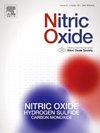Potential role of brain nitric oxide in inhibiting α7 nicotinic acetylcholine receptor-mediated suppression of the micturition reflex in rats
IF 3.2
2区 生物学
Q2 BIOCHEMISTRY & MOLECULAR BIOLOGY
引用次数: 0
Abstract
Brain nitric oxide (NO), produced by NO synthase (NOS), exerts both facilitatory and inhibitory effects on micturition. A functional relationship between NO and nicotinic acetylcholine receptors (nAChRs) has been indicated, and we previously reported that stimulation of brain α7 nAChR suppresses the micturition reflex in rats. In this study, we investigated which brain NOS isozyme is involved in micturition regulation and how NO influences α7 nAChR-mediated suppression. Cystometry was performed in urethane-anesthetized male rats using a bladder catheter. SNAP (NO donor), l-NAME (NOS inhibitor), 3-bromo-7-nitroindazole (neuronal NOS inhibitor), or BYK191023 (inducible NOS inhibitor) was administered intracerebroventricularly (icv) 3 h after the surgery. In some rats, the effects of pre-treated SNAP or l-NAME on PHA568487 (α7 nAChR agonist, icv)-induced responses were assessed. Intercontraction intervals (ICI)—the interval between two voiding bladder contractions—were recorded starting 1 h before the first icv administration. SNAP (30 nmol/rat) shortened ICI, whereas l-NAME (100 nmol/rat) and 3-bromo-7-nitroindazole (100 nmol/rat) prolonged ICI; BYK191023 had no effect. PHA568487 (1 nmol/rat) induced ICI prolongation, but this response was suppressed by SNAP (10 nmol/rat). At a lower dose (0.3 nmol/rat), PHA568487 had no effect on ICI unless l-NAME (30 nmol/rat) was pre-administered, which then revealed its significant ICI-prolonging effect. These findings suggest a possibility that brain endogenous NO, particularly from neuronal NOS, may be involved in the inhibition of brain α7 nAChR-mediated suppression of the micturition reflex in rats.
脑一氧化氮在抑制α7烟碱乙酰胆碱受体介导的大鼠排尿反射抑制中的潜在作用
脑一氧化氮(NO)由NO合成酶(NOS)产生,对排尿有促进和抑制作用。NO与烟碱乙酰胆碱受体(nAChR)之间的功能关系已被指出,我们之前报道过刺激脑α7 nAChR抑制大鼠的排尿反射。在本研究中,我们探讨了脑NOS同工酶参与排尿调节以及NO如何影响α7 nachr介导的抑制。用膀胱导管对经尿素麻醉的雄性大鼠进行膀胱测容。术后3 h脑室内给予SNAP (NO供体)、l-NAME (NOS抑制剂)、3-溴-7-硝基茚唑(神经元NOS抑制剂)或BYK191023(诱导型NOS抑制剂)。在一些大鼠中,我们评估了预处理SNAP或l-NAME对PHA568487 (α7 nAChR激动剂,icv)诱导的反应的影响。收缩间期(ICI) -两次膀胱排尿收缩之间的间隔-从第一次给药前1小时开始记录。SNAP (30 nmol/大鼠)缩短了ICI,而l-NAME (100 nmol/大鼠)和3-溴-7-硝基茚唑(100 nmol/大鼠)延长了ICI;BYK191023没有效果。PHA568487 (1 nmol/大鼠)诱导ICI延长,但SNAP (10 nmol/大鼠)抑制了这一反应。在低剂量(0.3 nmol/大鼠)下,除非预先给药l-NAME (30 nmol/大鼠),PHA568487对ICI没有影响,从而显示出其显著的ICI延长作用。这些发现提示,脑内一氧化氮,特别是来自神经元的一氧化氮,可能参与抑制大鼠脑α7 nachr介导的排尿反射抑制。
本文章由计算机程序翻译,如有差异,请以英文原文为准。
求助全文
约1分钟内获得全文
求助全文
来源期刊

Nitric oxide : biology and chemistry
生物-生化与分子生物学
CiteScore
7.50
自引率
7.70%
发文量
74
审稿时长
52 days
期刊介绍:
Nitric Oxide includes original research, methodology papers and reviews relating to nitric oxide and other gasotransmitters such as hydrogen sulfide and carbon monoxide. Special emphasis is placed on the biological chemistry, physiology, pharmacology, enzymology and pathological significance of these molecules in human health and disease. The journal also accepts manuscripts relating to plant and microbial studies involving these molecules.
 求助内容:
求助内容: 应助结果提醒方式:
应助结果提醒方式:


